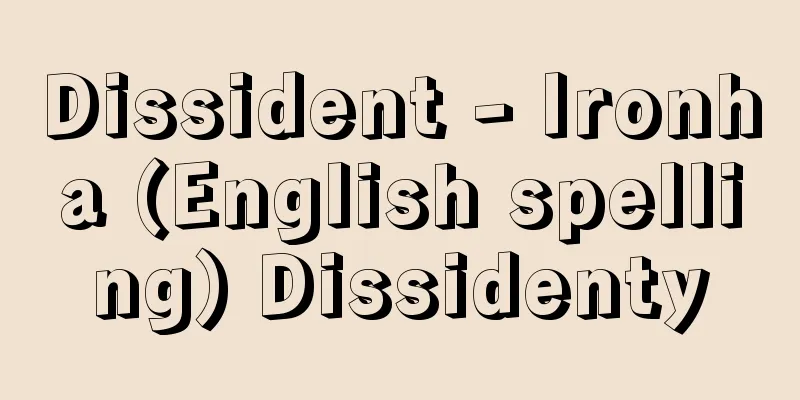Neighborhood relations (English spelling) Nachbarverhältnis German

|
Legal relations between adjacent real estate ownership. In order for adjacent real estate to fully utilize their functions, there are cases where the owners or users of those real estate must restrain each other from exercising their rights or cooperate with the other party. In this way, a relationship in which the content of ownership or use rights is legally restricted to a certain extent for the purpose of regulating the mutual use of adjacent real estate ownership (or use rights such as surface rights and leasehold rights) is called a neighboring relationship. It is stipulated quite specifically in the Civil Code (Articles 209 to 238). To give a few examples, (1) if there is a piece of land (a cul-de-sac) where one cannot get to a public road without passing through someone else's land, the owner of the other land surrounding that land (the surrounding land) must recognize the right of way (Articles 210 to 213). (2) A fence (a hedge, wall, etc.) can be erected between the neighboring house and the neighboring house can be required to bear the cost of the fence (Articles 225 to 228). (3) In order to construct a building, a distance of at least 50 centimeters must be kept from the boundary line (Article 234). In addition, there are detailed regulations regarding the use of water (Articles 214 to 222). These regulations were based on the social conditions up until the 19th century at best, and many of them are outdated when viewed from today's perspective, where civil engineering, architecture, and other science and technology have made remarkable advances and industrialization and urbanization have progressed. Furthermore, many problems that cannot be solved by these regulations alone may arise between neighbors, and these will likely be resolved by analogy with the spirit of the regulations on neighborly relations or by applying the principle of abuse of rights. Noise, vibration, smoke, odors, and obstruction of sunlight are also becoming major new neighborly problems that require resolution. There is also an increasing number of laws that attempt to regulate neighborly relations from a public law perspective, such as the Building Standards Act enacted in 1950. [Yasuyuki Takahashi and Masamitsu Nozawa] [Reference] | |Source: Shogakukan Encyclopedia Nipponica About Encyclopedia Nipponica Information | Legend |
|
相近接する不動産所有権相互間の法律関係。隣り合っている不動産が互いにその機能を十分に生かすためには、それらの所有者なり利用者が相互にその権利の行使を抑制し、あるいは相手方に協力しなければならない場合がある。このように、近接する不動産所有権(あるいは地上権・賃借権のような利用権)の相互の利用を調節することを目的として、所有権あるいは利用権の内容がある限度まで法的に制限される関係を相隣関係という。民法にかなり具体的に規定されている(209条~238条)。二、三の例をあげれば、(1)他人の土地を通らなければ公道に出られないような土地(袋地(ふくろじ))がある場合には、その土地を取り囲む他の土地(囲繞地(いにょうち))の所有者は通行権を認めてやらなければならない(210条~213条)。(2)隣家との間に囲障(垣根・塀など)を設置して、その費用を隣家にも負担させることができる(225条~228条)。(3)建物を築造するには境界線から50センチメートル以上の距離をとらなければならない(234条)。このほか、水の利用に関して詳細な規定が設けられている(214条~222条)。 これらの規定は、せいぜい19世紀までの社会の状況を前提としたもので、土木・建築その他の科学技術が著しく発展し、工業化・都市化の進んだ今日からみれば時代遅れのものが多い。また、これらの規定だけでは解決できない多くの問題が実際相隣者間には発生しうるが、それらについては、相隣関係に関する規定の精神を類推し、あるいは権利濫用の法理を適用して解決することになろう。騒音、振動、煤煙(ばいえん)、臭気、日照阻害なども、新しい相隣関係の問題として解決を迫られる重大な問題となってきている。なお、1950年(昭和25)に制定された建築基準法のように、公法面から相隣関係を律しようとする法律も増えている。 [高橋康之・野澤正充] [参照項目] | |出典 小学館 日本大百科全書(ニッポニカ)日本大百科全書(ニッポニカ)について 情報 | 凡例 |
Recommend
Kakioka - Kakioka
This area is located in the center of Ishioka Cit...
Quality of working life
It is also translated as "quality of working ...
Belly dance
A female dance seen in Islamic cultures from Weste...
Veṇuāroha (English spelling)
… Later scholars praised him as the “knower of th...
Ping-ju (English: Ping-ju)
Chinese regional drama. Also called "Pianxi&q...
Pitch difference - Onteisa
...This makes it possible to use many more keys t...
Mint - Inuyamahakka
…It is not a substitute for mint. The leaves of t...
IATA - IATA
Abbreviation for International Air Transport Assoc...
The Hundred Years' War
The Hundred Years' War is a state of conflict...
Keiga Kawahara
Year of death: Unknown (Year of death unknown) Yea...
Spectroheliograph
Also known as a spectroheliograph. A device for ph...
Carex incisa (English spelling)
…[Tetsuo Koyama]. … *Some of the terminology that...
Eneken - Eneken
...The water is pumped up by windmills and put to...
Dictyonema morrei (Nyl.) Henss.
A basidiomycete lichen of the Dictyonema family th...
Amrit
... Not much fine sculpture survives. A stele fro...









